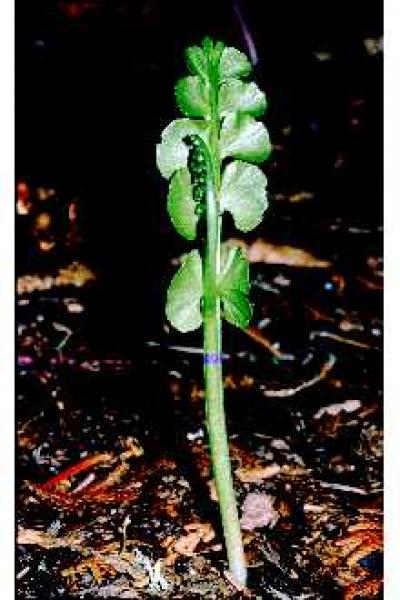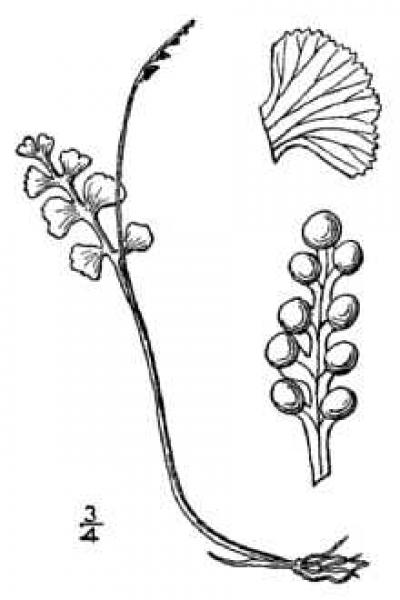Common Moonwort
Botrychium neolunaria Stensvold & Farrar
- Class
- Ophioglossopsida
- Family
- Ophioglossaceae (adder's-tongue family)
- State Protection
- Endangered
Listed as Endangered by New York State: in imminent danger of extirpation in New York. For animals, taking, importation, transportation, or possession is prohibited, except under license or permit. For plants, removal or damage without the consent of the landowner is prohibited.
- Federal Protection
- Not Listed
- State Conservation Status Rank
- S1
Critically Imperiled in New York - Especially vulnerable to disappearing from New York due to extreme rarity or other factors; typically 5 or fewer populations or locations in New York, very few individuals, very restricted range, very few remaining acres (or miles of stream), and/or very steep declines.
- Global Conservation Status Rank
- GNR
Not Ranked - Global conservation status not yet assessed.
Summary
Did you know?
Botrychium neolunaria was named by Carl Linneaus for the pinnae which have a crescent moon shape. The common name, moonwort, comes from this species but not all moonwoorts have crescent-shaped pinnae. In the past it was thought that these ferns could raise the dead, open locks, or remove the shoes of horses that tread upon them.
State Ranking Justification
There is only one known population and three historical populations. One of the historical populations is probably extirpated. This fern has always been considered rare in New York.
Short-term Trends
The only existing population has seen a reduction in numbers but the severity is complicated by the difficulty in counting individuals without harming them and the added difficulty of distinguishing them from the closely related Botrychium minganense. All the plants may not appear each year so long-term counts must be done to verify trends.
Long-term Trends
Only four locations were ever known for this fern. Plants still exist at one locality and habitat exists at another. The population along a road in Jamesville has not been seen since the 1870s and is probably gone.
Conservation and Management
Threats
The primary threat to Botrychium neolunaria is the loss of its open habitats to successional overgrowth and development. Trampling by visitors to the only known site is also a threat since the plants are small and easily overlooked.
Conservation Strategies and Management Practices
An evaluation of the management needs of the existing population should be undertaken.
Research Needs
A long-term demographic study should be undertaken to understand the biology and trends of this plant in New York.
Habitat
Habitat
This is a fern of northern white cedar forests and open pastures that are casually grazed where the underlying bedrock is calcareous. Often found with other moonworts (New York Natural Heritage Program 2005). Open fields, occasionally forests in southern occurrences (Flora of North America 1993). Open fields and meadows, or sandy or gravelly streambanks (Gleason and Cronquist 1991). In dry pastures, meadows, and on hillsides and rocky ledges (Cobb 1984). Open turfy, gravelly or ledgy slopes, shores and meadows, chiefly calcareous (Fernald 1970).
Associated Ecological Communities
- Alvar pavement grassland*
(guide)
This community consists of exposed, flat limestone or dolostone pavement with grassy or mossy patches interspersed throughout. Some examples may be solely grassland with no pavement.
- Calcareous talus slope woodland
(guide)
An open or closed canopy community that occurs on talus slopes composed of calcareous bedrock such as limestone or dolomite. The soils are usually moist and loamy; there may be numerous rock outcrops.
- Limestone woodland*
(guide)
A woodland that occurs on shallow soils over limestone bedrock in non-alvar settings, and usually includes numerous rock outcrops. There are usually several codominant trees, although one species may become dominant in any one stand.
- Pastureland
Agricultural land permanently maintained (or recently abandoned) as a pasture area for livestock.
* probable association but not confirmed.
Associated Species
- Acer spicatum (mountain maple)
- Arabidopsis lyrata
- Aralia nudicaulis (wild sarsaparilla)
- Botrychium minganense (Mingan moonwort)
- Cryptogramma stelleri (slender cliff-brake, Steller's cliff-brake)
- Dryopteris marginalis (marginal wood fern)
- Fragaria virginiana
- Mitella nuda (naked mitrewort, naked bishop's-cap)
- Thuja occidentalis (northern white cedar, arbor vitae)
Range
New York State Distribution
This plant is only known from one location in Onondaga County. There are 2 historical locations within Onondaga County, but only one known site. There is also an 1895 report (Prescott 1895) from northern Oneida County that includes a picture and seems very reliable.
Global Distribution
Botrychium neolunaria appears in North and South America, Eurasia, Australia, and New Zealand. In North America it occurs from Newfoundland and Labrador west to Alaska, and south to Massachusetts, New York, Michigan, Minnesota, Saskatchewan, New Mexico, Arizona, and California.
Identification Comments
General Description
Moonwort is a very small, perennial fern with a single aboveground frond. The dark-green frond is usually about 4 inches long and can be seen through mid-summer. It is divided into two leaves above a common stalk. The sterile leaf is usually dark green, thick, and fleshy. It has up to nine usually overlapping pairs of broadly fan-shaped leaflets (pinnae). The top edges are rounded and smooth or wavy or rarely have teeth. The fertile leaf is longer than the sterile leaf with branches that bear grape-like sporangia. Spores germinate underground and develop into tiny, non-photosynthetic gametophytes which depend on a fungus for nourishment.
Identifying Characteristics
Moonwort is a very small, perennial fern with a single aboveground frond. Frond to 10 cm tall, visible until midsummer. Sterile leaf dark green, thick and fleshy. Pinnae to 9 pairs, spreading, overlapping except in shaded forest forms. Pinnae broadly fan-shaped, undivided to tip, margins nearly entire or undulate, rarely denticulate, apical lobe usually cuneate to spatulate, notched, apex rounded, venation like ribs of a fan with no midrib. Fertile leaf 1-2-pinnate, 0.8-2 times the length of the sterile leaf.
Best Life Stage for Proper Identification
This fern is best identified when the leaves are fully formed.
Similar Species
Botrychium neolunaria is most easily confused with Botrychium minganense, Botrychium campestre, and Botrychium simplex. The pinnae of Botrychium minganense and Botrychium campestre are narrower, wedge shaped and do not overlap. Botrychium campestre has a shorter and more branched fertile leaf and the pinnae of the sterile leaf are often deeply divided at the top. It's leaves can only be seen in the spring. In Botrychium simplex the upper pinnules are somewhat fused together and not separate. The fertile leaf often arises from near the ground level. Botrychium matricariifolium pinnules are long and narrow with a central midrib and secondary segments. Reliable field determination of moonworts depends on the careful use of technical keys and comparison with silhouette outlines of verified specimens. Identification can be complicated because there is often a high degree of morphological variability between individuals in a population and between populations of the same species. Several species may grow together at the same site, and the few diagnostic characters may not be apparent in small plants.
Best Time to See
Mature fronds of this plant are visible from June to August. This should be the time of year when surveys for this species are conducted.
- Vegetative
- Fruiting
The time of year you would expect to find Common Moonwort vegetative and fruiting in New York.
Common Moonwort Images
Taxonomy
Common Moonwort
Botrychium neolunaria Stensvold & Farrar
- Kingdom Plantae
- Phylum Filicinophyta
- Class Ophioglossopsida
- Order Ophioglossales
- Family Ophioglossaceae (adder's-tongue family)
- Order Ophioglossales
- Class Ophioglossopsida
- Phylum Filicinophyta
Additional Common Names
- Moonwort
- Moonwort Grape Fern
- New World Moonwort
Synonyms
- Botrychium lunaria (L.) Sw.
- Botrychium lunaria var. onondagense (Underwood) House [This variety is now considered the shade form of Botrychium lunaria.]
- Botrychium onondagense Underwood [This species is now considered the shade form of Botrychium lunaria.]
- Osmunda lunaria L. [This is the original name applied by Linnaeus when he first described this fern.]
Additional Resources
Best Identification Reference
Flora of North America Editorial Committee. 1993. Flora of North America, North of Mexico. Volume 2. Pteridophytes and Gymnosperms. Oxford University Press, New York. 475 pp.
Other References
Cobb, Boughton. 1984. A field guides to ferns and their related familes, Northeastern and Central North America with a section on species also found in the British Isles and western Europe. The Peterson Field Guide Series. Boston, New York.
Crow, Garrett E. 1982. New England's Rare, Threatened, and Endangered Plants. Prepared for the United States Department of Interior, Fish and Wildlife Service, Northeast Region. June 1982.
Davenport, George E. 1877. Botrychium lunaria in New York State. Bulletin of the Torrey Botanical Club 6(34): 177.
Gleason, Henry A. and A. Cronquist. 1991. Manual of Vascular Plants of Northeastern United States and Adjacent Canada. The New York Botanical Garden, Bronx, New York. 910 pp.
Holmgren, Noel. 1998. The Illustrated Companion to Gleason and Cronquist's Manual. Illustrations of the Vascular Plants of Northeastern United States and Adjacent Canada. The New York Botanical Garden, Bronx, New York.
Lellinger, David B. 1985. A Field Manual of the ferns and fern-allies of the United States and Canada. Smithsonian Institution, Washington, D.C. 389 Pp.
Mitchell, Richard S. and Charles J. Sheviak. 1981. Rare Plants of New York State. Bull No. 445. New York State Museum. Univ. of New York. State Ed. Department Albany, NY.
Mitchell, Richard S. and Gordon C. Tucker. 1997. Revised Checklist of New York State Plants. Contributions to a Flora of New York State. Checklist IV. Bulletin No. 490. New York State Museum. Albany, NY. 400 pp.
New York Natural Heritage Program. 2010. Biotics database. New York Natural Heritage Program. New York State Department of Environmental Conservation. Albany, NY.
New York Natural Heritage Program. 2024. New York Natural Heritage Program Databases. Albany, NY.
Prescott, Adella. 1895. The Moonwort. The American Botanist 19:95-97.
Prescott, Adella. 1913. The Moonwort. American Botanist 19:95-97.
Reschke, Carol. 1990. Ecological communities of New York State. New York Natural Heritage Program, New York State Department of Environmental Conservation. Latham, NY. 96 pp. plus xi.
Stensvold, M. C., and D. R. Farrar. 2017. Genetic Diversity in the Worldwide Botrychium lunaria (Ophioglossaceae) Complex, with New Species and New Combinations. Brittonia 69(2):148–175.
Wagner, Florence S. 1988. Moonworts Recently Discovered in the Great Lakes Area. Fiddlehead Forum 15(1): 2-3.
Wagner, Jr., W.H. and F.S. Wagner. 1990. Moonworts (Botrychium subg. Botrychium) of the Upper Great Lakes Region, USA and Canada, with Descriptions of Two New Species. Contr. Univ. Mich. Herb. 17: 313-325.
Weldy, T. and D. Werier. 2010. New York flora atlas. [S.M. Landry, K.N. Campbell, and L.D. Mabe (original application development), Florida Center for Community Design and Research http://www.fccdr.usf.edu/. University of South Florida http://www.usf.edu/]. New York Flora Association http://newyork.plantatlas.usf.edu/, Albany, New York
Links
About This Guide
Information for this guide was last updated on: December 3, 2019
Please cite this page as:
New York Natural Heritage Program. 2024.
Online Conservation Guide for
Botrychium neolunaria.
Available from: https://guides.nynhp.org/common-moonwort/.
Accessed July 27, 2024.


